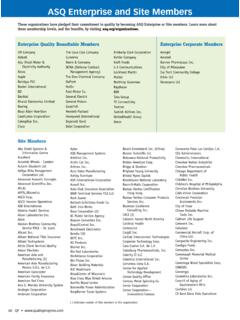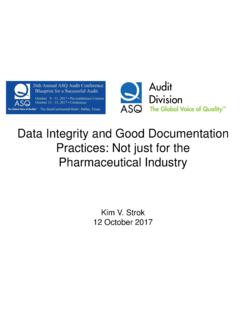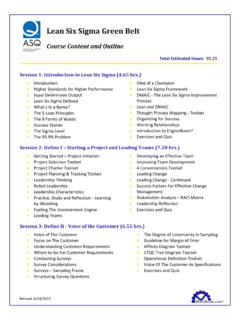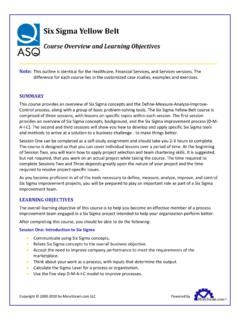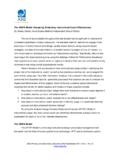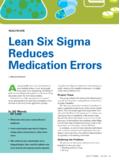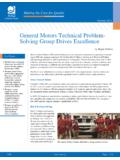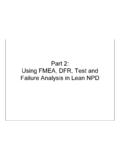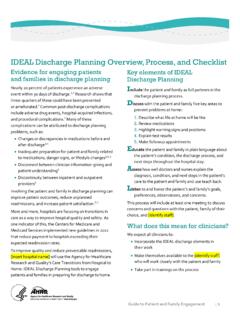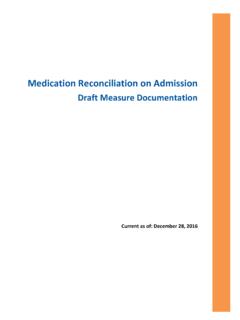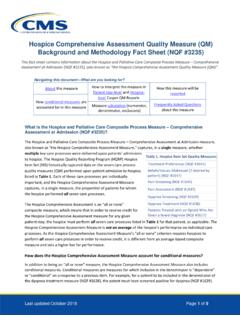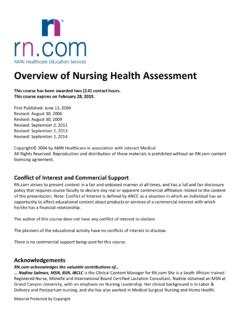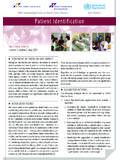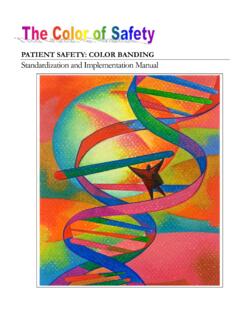Transcription of Using new Technology to Improve Patient Experience
1 ASQ's Healthcare Update: published in collaboration with the ASQ Healthcare Division Using new Technology to Improve Patient Experience New tools helped nursing staff in Ohio Improve Emergency Department admission times and facilitate communication between staff and patients . Within one year of implementation, the hospital saw a reduction in average length of stays, as well as overall costs. These improvements led to higher Patient satisfaction scores. By Stephanie Meade and Beth Pierce Background / Situation Like the majority of healthcare organizations across the United States, Mercy Health-West Hospital, in Cincinnati, OH, is making an active effort to reduce the time it takes to move a Patient from the emergency department (ED) through admissions and into the correct inpatient unit.
2 Studies1 of ED admission delays where the mode of disposition are admission to the ICU, surgery or inpatient wards, indicate that common outcomes are longer inpatient lengths of stay (upwards of 12%). and increased total inpatient cost (averaging 11%). Beyond these percentages, the practical outcomes for many hospitals are thousands of unnecessary inpatient days and millions of dollars in excess cost. West Hospital admits approximately 80% of our admissions through the ED. On a monthly basis, that translates to between 700 and 800 inpatient admissions from the ED.
3 One essential method used to ensure that patients and staff are connected is purposeful leader rounding. Rounding is a common method for visiting with patients to hear how they perceive their hospital Experience , which helps build trust and facilitates communication. Over a one-year period starting in August 2014, the nursing supervisors had rounded on nearly 5,100. patients admitted from the ED. With that volume of activity and operational impact, it was important for West Hospital to optimize the process and ensure the Patient Experience starts right.
4 Solution In May 2014, we initiated a quality improvement project to Improve the Patient ED Experience . Our hypothesis was that proactively managing Patient expectations when being admitted from the ED might have a direct impact on their overall inpatient Experience . The purpose of the project was to positively impact the overall inpatient Experience by addressing admission delays while the Patient was still in the ED through the implementation of nursing leadership rounding 24/7. Our intended outcomes were to systematically identify the perceived causes of delay; reduce delays.
5 Increase Patient satisfaction as measured by our Hospital Consumer Assessment of Healthcare Providers ASQ's Healthcare Update January 2016. ASQ's Healthcare Update: published in collaboration with the ASQ Healthcare Division and Systems (HCAHPS) score; and recognize staff members who, in the patients ' views, were especially helpful. Our initial approach was the implementation of a real-time paper rounding tool. The hospital nursing supervisor was responsible for rounding on all admissions from the ED prior to the Patient arriving on the inpatient unit.
6 This was a well-intentioned initial step that helped us better understand the process and the key data- collection elements. But, paper-based data collection and real-time response to defects proved to be two conflicting concepts, and this method did not match our intended improvement speed. In July 2015, working with a software company we shifted our approach to a cloud-based Digitizing the process in an ED flow application made a world of difference. The cloud approach provides a number of advantages. From an efficiency perspective, it is easy to securely access on any device.
7 So there is no need for paper, clip boards, or wondering what happened to the completed forms. Second, it's point-and-click so it's also fast and not a burden on staff time. From an effectiveness perspective, the application has the ability to immediately alert ED leadership when patients indicate concerns, as well as track and report trends in delays according to cause and specific inpatient unit. This translates into near-immediate reaction to defects and opportunities for improvement. Measuring the Results In just a few months, we have collected results from more than 4,300 patients admitted from the ED that have been rounded on by our staff.
8 To assess our results, we conducted a correlation analysis that demonstrated improved overall inpatient Experience scores with real-time rounding on ED admits. In addition to the correlation analysis, our daily data results are compelling: In the past year, delays have been reduced from approximately 43% to 9% at the time of this article (see graph below). ASQ's Healthcare Update January 2016. ASQ's Healthcare Update: published in collaboration with the ASQ Healthcare Division Moreover, the number of dissatisfied patients per month has decreased from an average of per 100, to per 100 in less than a year.
9 A great turnaround, but we still have room for improvement. A third area in constant need of attention is staff feedback and recognition. In the heat of day-to-day operations, it is often difficult to consistently identify and recognize the exceptional work of our staff. The implementation of the cloud-based application has provided a significant benefit in this key leadership area. With our patients ' direct feedback, we have found 345 opportunities to recognize the top performers on our staff. These come in the form of Daisy, , and Sunshine awards that are for team members who demonstrate excellence in the respective areas of clinical expertise, compassionate care, and service as role models.
10 Conclusion and Future Implications Our next step is the implementation of a similar real-time rounding tool that we will use to solicit feedback on patients who are scheduled for discharge from the ED. We are enthusiastic about Using these tools and processes to better engage with our patients and capture their perspectives on our performance. Improving Patient flow through the ED has the potential to reduce related costs and, most importantly, Improve the quality of care we provide at West Hospital. Reference and Note 1. Qing Hang, Amardeep Thind, Jonathan Dreyer, and Gregory Zaric, The Impact of Delays to Admission from the Emergency Department on Inpatient Outcomes, BMC Emergency Medicine, July 9, 2010.

